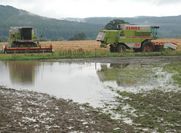Water and soil: Flood remedies

To avoid jeopardising their single farm payments farmers still need to record, in their obligatory Soil Protection Reviews, what they intend to do to reinstate the soil after what looks like being a soggy harvest, says Simon Draper, adviser with DEFRA agency Momenta.
Under the single farm payment system, the third condition requiring farmers to keep their land in Good Agricultural and Environmental Condition (GAEC 3) is there to protect soils from damage and erosion, he notes.
“Unfortunately, while there is a derogation, soils will be damaged and there is no easy cure for the problems farmers will face.
 “We are likely to see severe compaction and heavy rutting of fields. Soil compaction reduces the pore space between soil particles, reducing the land’s capacity to absorb water and air and this can be intensified when soil are wet.”
“We are likely to see severe compaction and heavy rutting of fields. Soil compaction reduces the pore space between soil particles, reducing the land’s capacity to absorb water and air and this can be intensified when soil are wet.”
The resulting deterioration in soil structure may increase the risk of soil erosion and accelerate run-off rates, he warns.
“Farmers need to address this compaction to prevent long-term environmental damage and to ensure high-yielding combinable crops next year.”
High cereal prices provide plenty of incentive to avoid yield losses from soil damage, says Mr Draper.
Fields must be returned to their most productive state as quickly as possible, and he suggests six options to consider for entry into Soil Protection Reviews.
Rough cultivate
As soon as harvest is complete and the soil is no longer waterlogged, rough cultivate to help dry the field out.
Wet soil soon becomes anaerobic, starving the soil of oxygen and destroying many of the microbes that live in the soil. These do build up quickly, but the longer the soil is anaerobic the more damage is done.
Rough cultivating will help dry the soil out and replace some of the oxygen in the soil.
Subsoil tramlines and ruts when dry enough
Once the field starts to dry, thoughts can turn to levelling it and removing the ruts caused by a wet harvest.
But subsoiling when it is too wet leads to “moling” and little shatter and levelling. So on the wettest fields the best option is to subsoil after the field has been roughly cultivated when there is more chance that it will have dried to the correct level.
Drill into a rough seed-bed
Even though fields have been roughly cultivated and left to dry they are likely to lack oxygen for some time, and will need long term care to put things right.
A rough seed-bed allows air to keep infiltrating the soil throughout the next crop’s life, but beware of slugs.
Avoid rolling
For growers afflicted by slugs, rough seed-beds and not rolling will be an anathema. But the pests also suffer badly when fields are flooded and their populations may have been greatly reduced. So test bait as soon as possible to determine the threat.
If slug levels are low then rolling should be avoided. That’s because rolled fields are more likely to cap and less air can get into them.
Change cropping
In very waterlogged fields drying will take a long time so it would be worth seeing if the crop rotation can be changed.
In normal weather winter wheat could still be an option, but oilseed rape should only be considered on drier, non-waterlogged fields.
The most seriously waterlogged land should be left for spring barley allowing more time to undertake all the required cultivations.
A dry spring seed-bed is likely to produce higher cereal yields and with the higher prices should give a substantial return next year.
Other options
Clearly there will be other options, which may be more suitable in different situations.
But whatever they are, the objective must be to return the land to as productive a state as possible, as soon as possible.
Record your choices in the Soil Protection Review
To stay cross-compliant do ensure, where damage to the soil by harvesting under too-wet conditions has occurred, that you record the option you have chosen to correct the problem in the Soil Protection Review.
This can be done by using the “comments” box on the right hand side of the crop choice pages.
In this box enter the field name where the problem has occurred and what option you have chosen to help correct the problem.

